German Navy
The Bundesmarine is primarily focused on control of the western Baltic, although they have interests in the North Sea and routinely send units to exercise and patrol with NATO forces. Maintaining Naval bases on both sides of the Jutland peninsula; Kiel on the Baltic and Wilhelmshaven on the North Sea joined by the Kiel canal for the exact purpose of transferring naval power form one coast to the other adds significant flexibility. As a rule, the larger ships, except the Lutjens Class Destroyers are based at Wilhelmshaven with easy access to the North Sea and Atlantic while the submarines, patrol boats, mine warfare craft and missile boats are at Kiel ready to join the Danes in defending the Baltic Approaches.
Destroyers
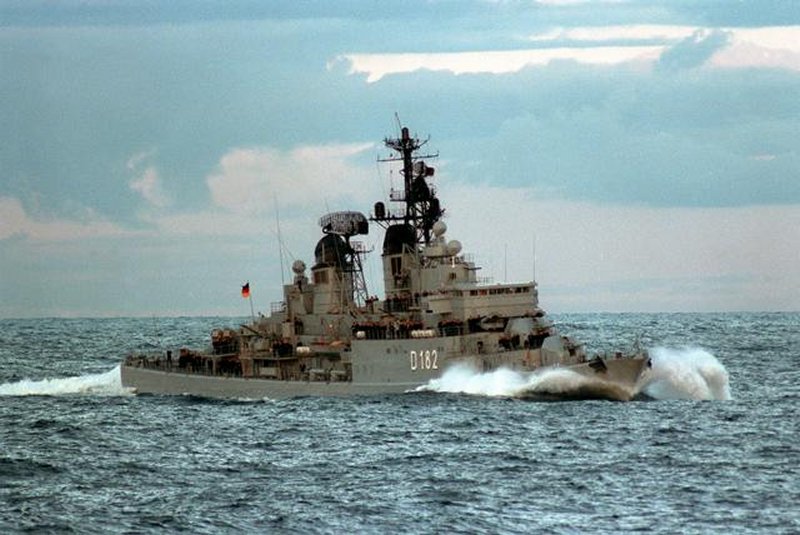
Hamburg Class: Built in the early 1960s these were the first warships built in Germany since the Second World War. They were not popular, had many faults, poor sea keeping characteristics, but they were useful in demonstrating that Germany could help protect the sea lanes that were key to its renewed growth. Built as an all gun ship, modernization in the 1980s replaced one of the 100mm gun turrets with Exocet Anti-Ship Missiles (ASM), obsolete Bofors guns were replaced with new Breda L70 40mm cannon, the radar and combat systems were improved. One of the original four ships retired in 1990 and the remaining three were historically decommissioned between December 1993 and December 1994, in Northern Fury those three remain active.
| Pennant | Class | Ship | Status | Location | Task |
|---|---|---|---|---|---|
| D 181 | Hamburg | Hamburg | Active | In Port | |
| D 182 | Hamburg | Schleswig-Holstein | Active | In Port | |
| D 183 | Hamburg | Bayern | Active | Baltic | Patrol |

Lutjens Class: These three ships were derived from the US Charles F. Adams Class of DDGs, although the differences between the two were not operationally significant. The primary role of this class was air defence which had been upgraded over time to field both the Standard SM-1MR medium range Surface to Air Missiles (SAM) and the RAM (Rolling Airframe Missile) short range SAM. Considering that they were built in 1969/70, their air defense capabilities was quite good.
| Pennant | Class | Ship | Status | Location | Task |
|---|---|---|---|---|---|
| D 185 | Lütjens | Lütjens | Active | In Port | |
| D 186 | Lütjens | Mölders | Active | In Port | |
| D 187 | Lütjens | Rommel | Active | North Sea | Patrol |
Frigates
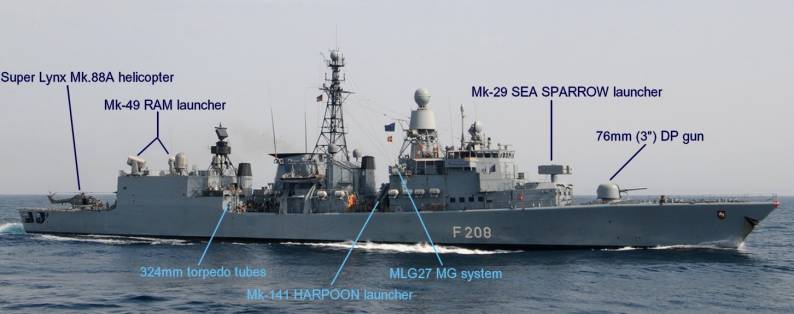
Bremen Class: The eight ships of this class form the backbone of the Germany Navy. Designed for Anti-Submarine Warfare (ASW) using the Dutch design for the very successful Kortenaer Class as a basis, they were all commissioned between 1982 and 1990 and were well rounded ships. The main purpose was protecting the sea lanes and contributing to convoy operations. They each carried two Lynx ASW helicopters, Harpoon ASMs and short range Sea-Sparrow SAMs and are being fitted with the RAM system as well.
| Pennant | Class | Ship | Status | Location | Task |
|---|---|---|---|---|---|
| F 207 | Bremen | Bremen | Active | In Port | |
| F 208 | Bremen | Niedersachsen | Active | Baltic | Patrol |
| F 209 | Bremen | Rheinland-Pfalz | Active | North Sea | Patrol |
| F 210 | Bremen | Emden | Active | Med | Training |
| F 211 | Bremen | Köln | Active | In Port | |
| F 212 | Bremen | Karlsruhe | Active | North Sea | Patrol |
| F 213 | Bremen | Augsburg | Active | In Port | |
| F 214 | Bremen | Lübeck | Active | In Port |

Brandenburg Class: FGS Brandenburg is the first of a four ship class designed to replace the Hamburg Class Destroyers. Her construction has been accelerated by about six months due to the re-emerging threat, and is in Wilhelmshaven completing her final fitting out before commissioning at war start. The other three ships have also been accelerated but are at least a year away from commissioning. Equipped with 2 Lynx ASW helicopters, Exocet ASM, Sea Sparrow, RAM and very modern sensors, these will be a valuable addition to the fleet.
| Pennant | Class | Ship | Status | Location | Task |
|---|---|---|---|---|---|
| F 215 | Brandenburg | Brandenburg | Fitting out | In Port | Mar 94 |
| F 216 | Brandenburg | Schleswig-Holstein | Launched | Feb 95 | |
| F 217 | Brandenburg | Bayern | Launched | Mar 95 | |
| F 218 | Brandenburg | Mecklenburg-Vorpommern | Building | Jun 96 |
Fast Attack Craft: The role of these ships is to defend the western end of the Baltic sea and in conjunction with the Danish Navy, prevent Soviet forces from escaping through the Baltic Approaches into the North Sea. All are based at Neustadt Navy Base, 40 nautical miles South East of Kiel and remain at high readiness to sortie quickly against any threat. The NATO pennant numbers are prefixed with ‘P’ while the local German pennant number is only two digits and is prefixed with an ‘S’.
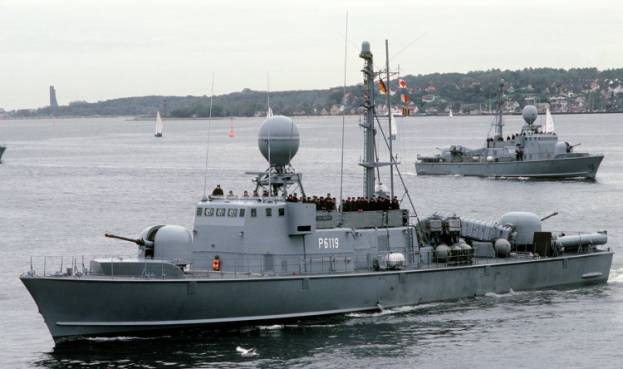
Albatros Class: Equipped with Exocet ASMs, torpedoes, and two 76mm Oto-Melara gun, these 400 tonne boats attack at 40Knts and depend on their speed, maneuverability and a few decoys to escape.
| Pennant | Class | Ship | Status | Location | Task |
|---|---|---|---|---|---|
| P 6111 (S61) | Albatros | Albatros | Active | In Port | |
| P 6112 (S62) | Albatros | Falke | Active | In Port | |
| P 6113 (S63) | Albatros | Geier | Active | In Port | |
| P 6114 (S64) | Albatros | Bussard | Active | In Port | |
| P 6115 (S65) | Albatros | Sperber | Active | In Port | |
| P 6116 (S66) | Albatros | Greif | Active | In Port | |
| P 6117 (S67) | Albatros | Kondor | Active | In Port | |
| P 6118 (S68) | Albatros | Seeadler | Active | Baltic | Patrol |
| P 6119 (S69) | Albatros | Habicht | Active | In Port | |
| P 6120 (S70) | Albatros | Kormoran | Active | In Port |

Gepard Class: Similarly equipped to the Albatros Class, the Gepards are a decade newer, have only one gun, more decoys and are equipped with the RAM short range SAM system with 21 missiles.
| Pennant | Class | Ship | Status | Location | Task |
|---|---|---|---|---|---|
| P 6121 (S71) | Gepard | Gepard | Active | In Port | |
| P 6122 (S72) | Gepard | Puma | Active | In Port | |
| P 6123 (S73) | Gepard | Hermelin | Active | In Port | |
| P 6124 (S74) | Gepard | Nerz | Active | Baltic | Patrol |
| P 6125 (S75) | Gepard | Zobel | Active | In Port | |
| P 6126 (S76) | Gepard | Frettchen | Active | In Port | |
| P 6127 (S77) | Gepard | Dachs | Active | In Port | |
| P 6128 (S78) | Gepard | Ozelot | Active | In Port | |
| P 6129 (S79) | Gepard | Wiesel | Active | In Port | |
| P 6130 (S80) | Gepard | Hyäne | Active | In Port |
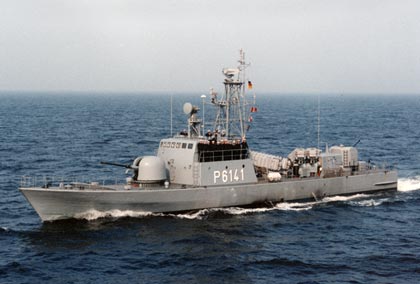
Tiger Class: The oldest of the three classes of FAC in the German Navy, these have Exocet ASMs and two Oto-Melara 76mm guns, but also a Bofors 40mm gun instead of SAMs. Slightly slower and 130 tonnes lighter than the other two classes, the 20 boats of the Tiger Class will have difficulty surviving in the highly contested Baltic Approaches.
| Pennant | Class | Ship | Status | Location | Task |
|---|---|---|---|---|---|
| P 6140 (S40) | Tiger | Kalypso | Active | In Port | |
| P 6141 (S41) | Tiger | Tiger | Active | In Port | |
| P 6142 (S42) | Tiger | Iltis | Active | In Port | |
| P 6143 (S43) | Tiger | Luchs | Active | In Port | |
| P 6144 (S44) | Tiger | Marder | Active | In Port | |
| P 6145 (S45) | Tiger | Leopard | Active | In Port | |
| P 6146 (S46) | Tiger | Fuchs | Active | In Port | |
| P 6147 (S47) | Tiger | Jaguar | Active | In Port | |
| P 6148 (S48) | Tiger | Löwe | Active | In Port | |
| P 6149 (S49) | Tiger | Wolf | Active | In Port | |
| P 6150 (S50) | Tiger | Panther | Active | In Port | |
| P 6151 (S51) | Tiger | Häher | Active | In Port | |
| P 6152 (S52) | Tiger | Storch | Active | In Port | |
| P 6153 (S53) | Tiger | Pelikan | Active | In Port | |
| P 6154 (S54) | Tiger | Elster | Active | In Port | |
| P 6155 (S55) | Tiger | Alk | Active | In Port | |
| P 6156 (S56) | Tiger | Dommel | Active | In Port | |
| P 6157 (S57) | Tiger | Weihe | Active | In Port | |
| P 6158 (S58) | Tiger | Pinguin | Active | In Port | |
| P 6159 (S59) | Tiger | Reiher | Active | In Port | |
| P 6160 (S60) | Tiger | Kranich | Active | In Port |
Submarines: German shipyards build some of the best diesel powered submarines in the world – for other navies! The only submarines, or U-Boats operated by the Germany Navy are the Type 205 and 206 designs, far smaller and less effective, but cheaper to build and operate than the Type 209/210 designs that are used by a dozen (in 1994) countries around the world. Design and testing is ongoing for the most advanced versions of the type 209 and even the type 212/214. Still the German boats are very effective and well suited for the shallow and confined waters of the Baltic Sea.
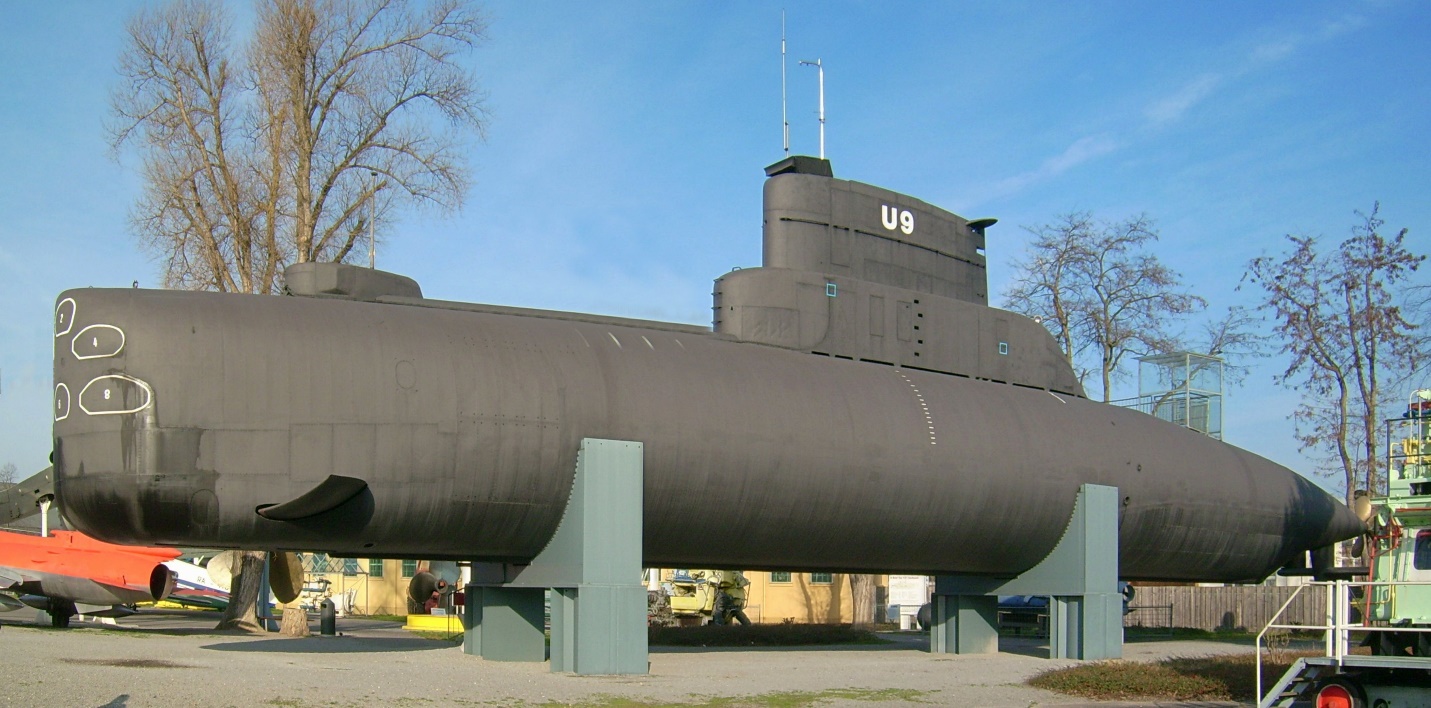
Type 205/205A: Only four boats remain active in this class, although two were supposed to retire in 1993, they did not. At a displacement of 450 tonnes submerged and with a crew of 22, these are very small, but also very quiet subs. The Type 205 has a single hull, the Type 205A has a double hull, neither were non-magnetic but were made of a much better and less magnetic steel than earlier designs.
| Pennant | Class | Ship | Status | Location | Task |
|---|---|---|---|---|---|
| S 188 | Type 205 | U-9 | Active | Baltic | On Patrol |
| S 189 | Type 205 | U-10 | Active | In Port | |
| S 190 | Type 205A | U-12 | Active | In Port | |
| S 191 | Type 205A | U-12 | Active | In Port |
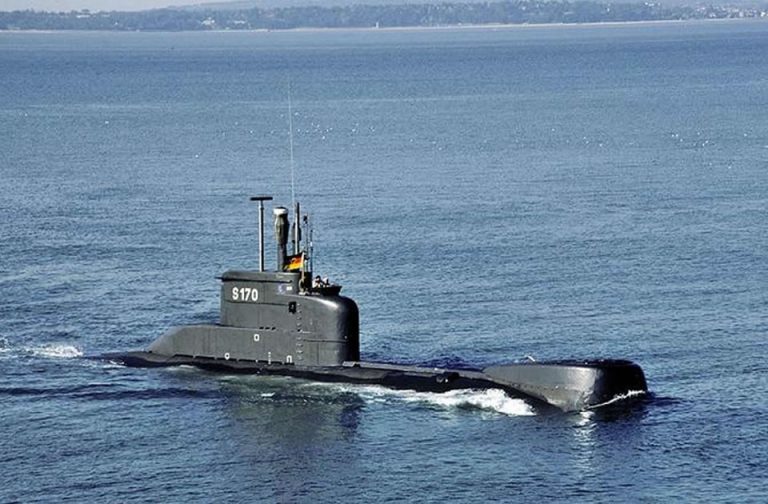
Type 206: This type is not much larger than the Type 205 but its systems are more advanced and it has a non-magnetic steel hull. 18 were built and 12 were upgraded to the Type 206A standard with a new sonar, periscopes, weapons control system, ability to use newer torpedoes and a refurbished propulsion system.
| Pennant | Class | Ship | Status | Location | Task |
|---|---|---|---|---|---|
| S 192 | Type 206 | U-13 | Active | In Port | |
| S 193 | Type 206 | U-14 | Active | In Port | |
| S 194 | Type 206A | U-15 | Active | In Port | |
| S 195 | Type 206A | U-16 | Active | In Port | |
| S 196 | Type 206A | U-17 | Active | In Port | |
| S 197 | Type 206A | U-18 | Active | In Port | |
| S 198 | Type 206 | U-19 | Active | In Port | |
| S 199 | Type 206 | U-20 | Active | In Port | |
| S 170 | Type 206 | U-21 | Active | In Port | |
| S 171 | Type 206A | U-22 | Active | In Port | |
| S 172 | Type 206A | U-23 | Active | In Port | |
| S 173 | Type 206A | U-24 | Active | In Port | |
| S 174 | Type 206A | U-25 | Active | In Port | |
| S 175 | Type 206A | U-26 | Active | In Port | |
| S 176 | Type 206 | U-27 | Active | In Port | |
| S 177 | Type 206A | U-28 | Active | Baltic | Patrol |
| S 178 | Type 206A | U-29 | Active | In Port | |
| S 179 | Type 206A | U-30 | Active | In Port | |
| S 194 | Type 206A | U-15 | Active | In Port |